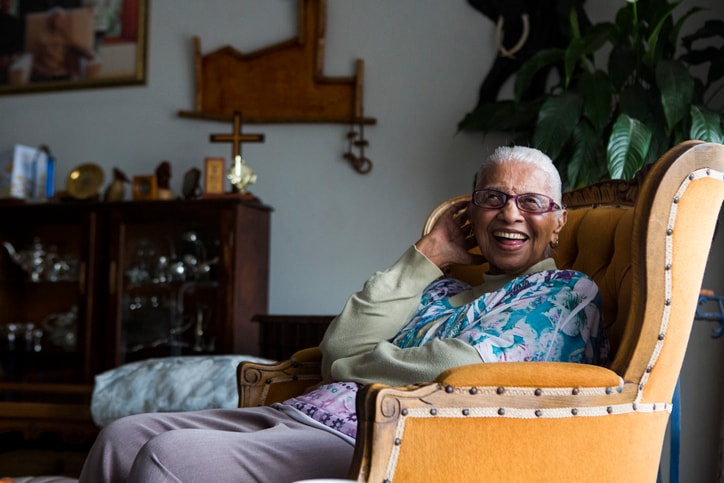A 2024 AARP survey found that most adults age 50 and older — about 75% — want to stay in their current homes as they grow older, rather than move to a new residence or care facility. This desire to “age in place” is even more common among adults 65 and older, as well as those living in small towns or rural areas, where a strong sense of community and familiarity with surroundings often play a key role in the decision.
Aging in place often involves making home modifications, hiring in-home care services, relocating or utilizing other helpful local resources. Here are some of the key considerations when preparing a future-ready home for aging well.
Key takeaways
- Most adults 50 and older — especially those 65+ or living in rural areas — want to age in place, remaining in their homes and communities as they grow older rather than moving to a facility. This preference reflects a strong desire for independence, comfort and connection to familiar surroundings.
- Successfully aging in place often requires home modifications and planning, such as widening doorways, improving lighting, or adding grab bars to enhance safety and accessibility. Consulting a Certified Aging in Place Specialist or exploring senior-friendly housing options can make these transitions easier and more affordable.
- Seniors can also consider alternative options like moving into a “village” community, hiring in-home caregivers, or living with family members — all while maintaining autonomy. Planning early for housing, care and safety systems ensures a smoother, more empowered aging experience.
What is aging in place?
Aging in place refers to the ability of an older adult to live in their own home and community safely, independently (or semi-independently with some assistance) and comfortably as they age — rather than move to a senior assisted living facility, nursing home or other institutional setting. The goal here is to try to maintain yours or your loved one’s quality of life and autonomy for as long as possible.
How can I prepare myself or a senior loved one to age in place?
Often aging in place requires making some changes to ensure the home is as safe as possible and can meet the senior’s physical needs as they get older. It’s also important that you or your loved one is in a community that is accessible to the services and support needed.
Modify your existing home to age in place
As you or your loved one age, several physical changes can make it important to modify the home. Seniors are more at risk for falls because of balance issues, and they may experience reduced mobility, vision loss and deal with chronic health conditions.
To make the home more comfortable and safer, you may consider:
- All-around modifications: Widening doorways, adding more lighting, changing flooring to prevent trip hazards, changing all doorknobs to easy-to-use handles, adding handrails near the bed and getting chairs that have an armrest.
- Kitchen modifications: Raising the height of appliances and installing pull-out shelves or a small kitchen island with seating can offer a safe workspace to prepare meals.
- Bathroom modifications: Adding an elevated toilet seat and grab bars to make getting in and out of the tub easier.
If you need help remodeling, consult a Certified Aging in Place Specialist (CAPS), a contractor who has undergone special training to help homeowners make age-related home modifications.
Relocate to a home that better supports aging in place
Sometimes aging in place also may mean finding another home in your current community. If your current home is multiple levels with lots of stairs, you may want to opt for one-level living instead in a ranch-style home or an apartment.
Housing affordability will play a huge role in this. Some communities have set aside affordable housing for those 55 and older or other people whose income qualifies. The Department of Housing and Urban Development (HUD) also sponsors several subsidized housing programs for seniors. It’s also worth checking with your state’s housing department to see if it offers rental assistance, vouchers or other subsidized programs for senior housing.
Author and former social worker Jody Gastfriend mentions the option of moving into a senior “village” in her book “My Parent’s Keeper“:
“Consider the Village movement, a growing option for seniors who want to ‘age in place,’ staying in their homes and communities. Members of the ‘Village’ pay an annual fee, ranging from $150 to over $500, for access to discount services such as transportation, home modification and repair, in-home care, and meal delivery.
Villages don’t deliver the services themselves; they work with pre-screened providers that offer preferred rates. Since the majority of seniors want to age in place, the Village concept allows them easy access to supports that help them do just that. Go to the Village to Village Network website to find out if there is a village near you.”
Read more:
Intentional communities and villages for seniors
Hire a caregiver
Whether you choose to remain in your current home or purchase a new one, you may need help with caregiving. Many agencies offer these services, but you also can hire an in-home caregiver privately by searching vetted, secure websites and directories, including Care.com.
Can I or a loved one age in place in a family member’s home?
In some cases, you may have to age in place in the home of an adult child or another family member. Caregiving can be a challenge even if a loved one lives 30 minutes away, so moving in with a relative — where you have your own dedicated space — may be a good compromise, especially if your family cannot afford assisted living.
But before this happens, have a discussion with your family and set the proper boundaries. Even if a senior ends up living with a family member, they still want some autonomy and independence. Openly communicate your expectations so that everyone has the same understanding.
Plan for additional safety
Even if you do hire an in-home caregiver or live with a family member, consider installing a sensor-based remote monitoring or personal emergency alert system so that you can easily access help if you ever need it and so that your loved one’s or caregivers can make sure you’re safe.
So what’s next?
Everyone wants to grow old with dignity, and for many seniors that means aging in place in surroundings in which you’re comfortable. However — and especially if you have your mind set on aging in place — it’s a good idea to make plans now before you actually need to.
Work with your family and friends or seek the necessary support services to make modifications to your home, to line up affordable or subsidized housing and to research in-home caregivers. Preparing for this transition now will make things a lot easier later on and help you feel more in control of how you age and where you do it.





